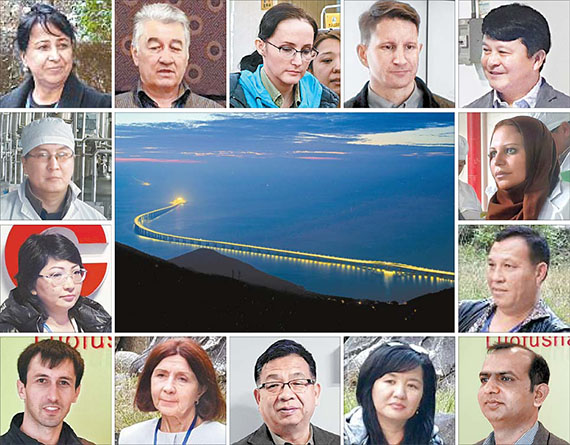An invitation from China

The author is senior editorial writer of the JoongAng Ilbo.
Technology prowess and a revival of Sinocentrism are the main drives behind China’s ambitious “One Belt, One Road” initiative led by Chinese President Xi Jinping. The 21th century version of Silk Road — where all paths on both ground and sea led to China — is the action plan for the Chinese dream. The grand idea: To recreate a glorious past in which China was the center of the world.
The Chinese government invited 20 reporters from 10 countries — including Russia, Uzbekistan, Kazakhstan, Kyrgyzstan, Tajikistan, Egypt and Pakistan — to tour coastal cities along Guangdong and Fujian Provinces at the year’s end and the beginning of the new year. Except for a South Korean reporter, all others came from countries involved in the “One Belt, One Road” project. They were invited to follow the track of a sea path from 600 years ago and study how much the cities along it have changed. The trip covered vibrant cities such as Guangzhou, Zhuhai and Huizhou in Guangdong Province, and other prospering cities like Xiamen, Quanzhou and Fuzhou in Fujian Province.
The pilgrimage began from an research and development hub in Huang Pu district of Guangzhou, home to a myriad of high-tech enterprises and start-ups. Drone maker EHang was one. It stunned the world with the Ehang 216, a 340-kilogram (750-pound) all-electric aerial vehicle capable of carrying two passengers. The company envisions aerial commuting services from Guangzhou to global cities. Tours included electronics maker TCL, as well as a producer of 3-D building security systems based on CCTV cameras. China was clearly no longer the world’s factory base.
In Zhuhai, visitors were able to witness the advance of Chinese engineering skills by crossing a 34-mile bridge across the Pearl River Delta that connects Hong Kong and Macau. The world’s longest sea-crossing bridge was opened in October 2018 after eight years of construction, costing $11.2 billion. It is touted as one of the world’s “seven miracles.”
Fujian, home to 38.6 million people, still bears reminders that it was a gateway of the maritime Silk Road. China’s oldest Islamic mosque, Qingjing, located in Quanzhou, was built in 1009 during the Northern Song Dynasty, suggesting the city has been connected to the world by sea as far back as the 11th century. Between 1405 and 1433, a fleet from the Ming Imperial navy under Admiral Zheng He sailed from Fuzhou to the Indian Ocean seven times, reaching as far as Africa.
One cannot judge China from a quick tour. Guangdong leads the Chinese economy. With a population of 113 million, its GDP is valued at $1.4 trillion, near South Korea’s $1.72 trillion. It is the wealthiest province in China. The per capita GDPs in Guangzhou and Zuhai are $23,000 and $23,900, respectively, more than double the average $10,000 of 1.4 billion Chinese people.

Twenty Journalists from 10 countries around the world were invited to 밇xperience China??a promotional tour organized by the China News Service, the second largest state-owned news agency in China after the Xinhua News Agency ?to enhance their understanding of China뭩 밢ne Belt, One Road?initiative. [AP/YONHAP]
The skylines were filled with cranes, underscoring the development in progress. The economy was still red-hot. Huizhou — also a part of the Pearl River Delta with a per capita GDP of $12,500 — was entirely under redevelopment. An administrative official told us that an apartment sells for 20,000 yuan ($2,910) per 3.3 square meters (35.6 square feet) and its value could double in five years.
The government sponsored the tour for one purpose: promoting the “One Belt One Road” initiative. The target countries are mostly poor. They can only be tempted by Chinese capital and promise of co-prosperity.
“The ‘One Belt, One Road’ initiative will be a win-win for China and other countries along the Silk Road path,” pitched Xia Chunping, deputy president of China News Service, which sponsored the tour.
“One Belt, One Road” envisions a renaissance of the Chinese race and the dream of their leader Xi Jinping. Economically, it would put China at the center of an economic bloc through a commerce and transportation network. Politically, it wants to establish a shared hegemony in the global order with the United States.
So why was a South Korean journalist invited? It may have been a message to Koreans to get behind China for economic reasons even if an alliance with the United States is needed on the security front. South Korea may soon have to make a choice on whether to join the U.S.-led Indo-Pacific framework or the new China-led order.

A group of foreign journalists pose for a commemorative shot in Xiamen Harbor, Fujian Province, during the “Experience China” tour.
The Silk Road is believed to have been opened around 202-220 B.C. It was most active in during the Tang Dynasty (618-907). The Chinese enjoyed their heyday under the powerful Han and Tang eras. The 21st century revival aims to bring back that glory.
The Ming imperial fleet crossed the Indian Ocean and arrived at the shores of eastern Africa through seven sea trips over 28 years from 1405 — nearly 90 years before Christopher Columbus discovered the New World.
Chinese President Xi Jinping first spoke of creating a new Silk Road during a visit to Kazakhstan in September 2013 and a maritime route on a trip to Indonesia in November 2013. The projects aims to cross Central Asia to Europe on the ground and connect northern China and the coastal lines of southern China with Southeast Asia, Africa, the Middle East and Europe. It will become a global gateway on ground and sea.
Various roads, railways, ports, pipelines and other infrastructure are being constructed on the new Silk Road. Over 100 countries from Asia, Africa, the Middle East and the European Union and international organizations backed the plan.
JoongAng Ilbo, Jan. 17, Page 26










with the Korea JoongAng Daily
To write comments, please log in to one of the accounts.
Standards Board Policy (0/250자)